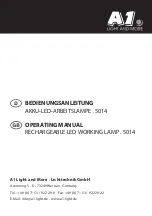
Latest products and information available at www.sealite.com
53
SL-PEL Series
Sectored Port Entry Light
Maintenance and Servicing
The PEL should be galvanically insulated from the bracket or tower it is mounted on by means of M10 A4
stainless bolts with insulated nylon washers to ensure the longevity of the PEL.
Pin “D” core coloured green should be connected to a suitable GROUND on the structure. Although the
lantern is protected against power surges everything should be done to safeguard the lantern from direct
or near lightning strikes.
The Sealite PEL is an LED light source and as a result does not require visits for re-lamping. If fitted
with GSM or AIS monitoring the service technician will already have advance notice on the requirement
for a visit.
In the absence of any alarms it is recommended that the PEL be visited twice a year to suit site
conditions. These conditions could be particularly where the light is exposed to season bird fouling or
sand/dust deposits from harsh winds or it could be access is difficult during certain times of the year.
Service personnel visiting the site should perform site visits with at least 5 litres of fresh, grit free soapy
water and clean rags to remove any external build up of sand or bird guano.
Before starting work Port Control should be contacted or the channel checked to ensure there is not a
SHIP IN PASSAGE which this cleaning process will prevent from using.
Special care should be taken when handling the Port Entry Light. Optics can be easily damaged from
poor handling and incorrect cleaning methods. Be sure to consider the following guidelines:
- Never place hard or rough surfaces on PEL optics as the lens can be easily scratched and chipped.
- Optics should never be handled with bare fingers as oils from the skin may remove and damage
coated and uncoated surfaces.
- Use only lint-free cloths or lens tissue when cleaning surface of the PEL lens
- Apply isopropyl alcohol (IPA) directly to your cloth – NEVER directly to the lens. Use slow, even, light
pressure working from edge to edge across the PEL Lens allowing IPA to evaporate
- If storing the PEL ensure the optics and connectors are protected.
The same cleaning process should be taken into consideration with any accessories including: solar
arrays, GSM or GPS units.
All cable connections should be checked and tied down against wind and wave actions if applicable.
Mounting fixings should be fixed for security and any weaknesses observed and noted.
Pictures should be taken of the site condition before and after these actions.
Once free of these deposits and dried with power still connected, using the USB lead and PC loaded
with the programme the Unit can be read to check and record battery voltage.
If the visit is other than regular maintenance the “event log” will be filled with up to 24 events. These
events are recorded in the PEL RAM and are retained even if power has failed.
The PEL cannot be read until it is powered up and COMs port selected as explained earlier in the
manual. Events can be down loaded to a separate file for record purposes.






































